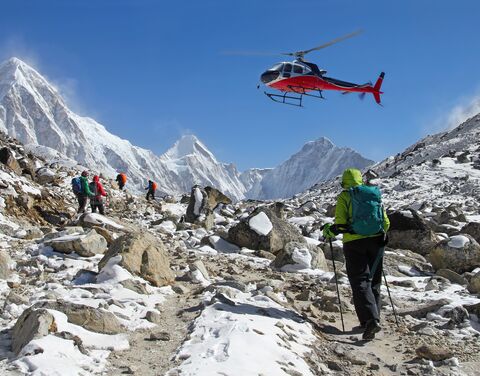
Rega or ambulance: who pays in an emergency?
Emergency transportation by Rega or ambulance is expensive. Many people are surprised at how much they have to pay themselves, despite having health insurance. We’ve put together all you need to know so that you’re prepared in the event of an emergency.
Air rescue: an expensive undertaking
Lisa is limping to the sofa with a small stack of post. After propping up her injured right leg, she rips open the letter bearing her health insurance company’s logo - it’s the bill that she’s been dreading for weeks. The student skips over the words: Rega is charging her a total of CHF 4,270! And basic insurance is covering just half of this cost. Lisa is speechless. How is she supposed to pay her share - on top of the franchise deductible and co-payment she has to pay following her unexpected stay in hospital?
Mountain rescue: basic insurance only pays 50 percent
Lisa had planned to work as a care assistant in a nursing home for the summer following her semester exams. But before she started, she pampered herself with a relaxing week’s walking in the mountains. However, one false step during a descent threw Lisa’s plans and her budget out of the window: she broke her leg in an accident which happened in such an awkward location that it took the Rega helicopter a long time to reach her, and the patient transfer to the nearest hospital’s accident & emergency unit was extremely expensive.
Lisa's problem: as a full-time student, she can only work on a temporary basis and is therefore covered for accidents through her basic insurance. This only pays 50 percent of the transportation costs, up to an annual maximum (see checklist).
Expensive trip in an ambulance
If you’re not covered for accidents through your health insurer, but through your employer, you are better off than Lisa, as in this instance, accident insurance would pay the full cost.
But rescue transportation can also be costly for you – if, for example, you suffer an attack of lumbago, an asthma attack or even a heart attack. This is because, in the event of an illness, basic insurance is responsible and charges you at least 50 percent of the costs.
Rescues can definitely be very costly, whether by air or ambulance. Depending on the region, it costs up to CHF 2,000 to be transported by ambulance. The costs soon add up to a considerable sum with franchise deductible, co-payment and uncovered costs.
Checklist on the cost of Rega or ambulance
Everything has to be done quickly in an emergency. This is why it is that much more important to be aware in advance of what costs can be insured with a Rega flight or transportation by ambulance - and then cover yourself if necessary. Look at our overview to see what you may have to pay in an emergency.
Accident or illness?
- If you’re involved in an accident, the employer’s accident insurance pays 100 percent of the transportation costs, but basic insurance only covers 50 percent.
- If you’re ill, basic insurance only pays 50 percent of the cost:
- if you have to be transported, the annual maximum contribution is CHF 500.
- if you have to be rescued, the annual maximum contribution is CHF 5,000.
You can fill these gaps by taking out supplementary health insurance or travel insurance.
Transportation or rescue?
- Transportation means that a sick or injured person has to be conveyed to the treatment site, regardless of whether by ambulance, helicopter or plane. Professional medical care is required en route.
- Rescue means that a patient has to be removed from a life-threatening situation, such as by helicopter.
Switzerland or abroad?
- The health insurance also pays for the cost of transportation when you’re abroad. The same conditions apply as in Switzerland.
- The health insurance does not pay for the cost of rescues when you’re abroad.
- Recovery missions, search missions and repatriations (being brought home) when you’re abroad are not covered by basic insurance either.
You can close these gaps by taking out supplementary health insurance or international health insurance.
A Rega patronage is not an insurance policy
If Lisa had been a patron of the Swiss Air Rescue Rega, this might have saved her some worries. This is because Rega can waive the rescue costs for their patrons if their rescue mission is not or only partially covered by insurance. There is no legal claim to a cost waiver, as Rega is a charitable foundation and not an insurance policy. The primary objective of a patronage is to fund unprofitable air rescues, as Rega would not exist without patrons. Hence, a Rega patronage should not be confused with supplementary insurance. The ideal scenario is to have both: supplementary insurance and a Rega patronage that is triggered if an insurer is not obliged to pay benefits and that organizes Rega helicopters in an emergency.
Many supplementary insurance policies close the gaps in transportation and rescue costs. For example, supplementary insurance from AXA covers the costs of transportation by ambulance or Rega flight up to CHF 100,000 in Switzerland; it even covers the full cost of rescue missions, transportation and repatriation (no upper limit) when you’re abroad.
An alternative to supplementary insurance is travel insurance: anyone taking out the Personal Assistance module is covered for the costs of rescue, recovery and transportation. Supplementary insurance would have paid off for Lisa, despite or exactly because of her tight budget.
Useful information on the rescue service
Regardless of whether by rescue helicopter or ambulance: if you’re out and about, and something happens where medical assistance is needed. But what happens in a real emergency?
Emergency call
An emergency call is made in a medical emergency in Switzerland or abroad by dialing 144 (Switzerland) or 112 (Europe), or via the Rega app or other channels.
Control center
The control center takes down the key details in an emergency situation. Key details are:
- Who’s making the call?
- Where is the site of the emergency?
- If an emergency app such as WayGuard or the Rega app is used, the location will be automatically transmitted.
- What happened?
- Is the patient responding or are they unconscious?
Deployment
Depending on the answers, the specialist in the control center collects important information and can then make the initial decisions. For example, whether the patient should be transported by ambulance or rescue helicopter. The specialist also transmits the key information to the rescue team so that it can provide on-site first aid as quickly as possible.
You can find more information on the deployment of Rega helicopters in this article on Rega.




